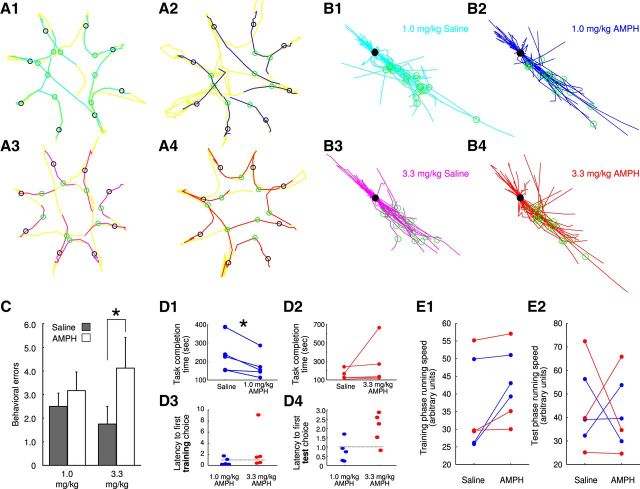Figure 1.
Effects of AMPH on behavior. A, The path of a SAL-treated animal (A1) and the same animal treated with 1.0 mg/kg AMPH (A2) is shown. Similarly, the path is shown from an animal given SAL (A3) or 3.3 mg/kg AMPH (A4). In these panels, the path of the animal during the choice and reward epochs is highlighted in cyan, blue, magenta, or red, corresponding to treatment group. Behavior that does not belong to the choice or reward epoch is shown in yellow. The point in the trajectory that was assigned as the “choice point” is denoted with the green circle, whereas the reward point is denoted by the black circle. The delay and incorrect choice epochs are omitted from these figures for clarity. In B, every test and training phase correct choice is shown for six animals. As previously, the color of the trajectory denotes treatment group, and the circles denote the choice (green) and reward (black) points. To visualize the approach of the animal to the reward, the location was rotated as if each reward was in the same location, and, as such, no appreciable changes in approach behavior were detectable. C, The 1.0 mg/kg dose of AMPH had no significant effect on behavioral errors during the DSWSh. In contrast, the 3.3 mg/kg dose increased errors relative to SAL injection. In D, the time to complete the task in the 1.0 mg/kg group (D1) and the 3.3 mg/kg group (D2) was assessed. Each line represents an animal. Decreased task completion time was observed in the 1.0 mg/kg group (*p < 0.05, paired t test). No detectable differences were observed in the normalized (AMPH/Saline) latency to first training phase choice (D3) or the first test phase choice (D4). In E, running speed was assessed across each treatment group during the training (E1) and test (E2) phases. A trend toward an increase in running speed was observed in the training phase (p = 0.07, paired t test) but not in the test phase.

